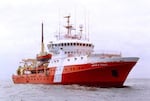
The John P. Tully 3, the Canadian Coast Guard vessel that sampled Pacific Ocean waters for Fukushima Radiation
CCGS
Since the Japanese earthquake and Fukushima nuclear disaster of 2011, radiation has been drifting on ocean currents toward the West Coast of North America.
Scientists tracking the radiation are using their data not just to gauge threats to human health, but to bolster the science of climate change, as well.
"This is kind of an experiment that's never really been conducted before in our lifetime," says John Smith of Canada's Bedford Institute of Oceanography.
What’s unique is that researchers know the exact origin and time frame the Fukushima radiation was released. Then, when they detected the radiation out in the ocean, they were able to create accurate maps of where and how quickly the radiation is moving.
Smith and a team of scientists used this to their advantage, publishing the first paper outlining the spread of cesium-137 eastward from Japan.
They concluded that since the radiation is coming over on ocean currents, the data they collected are good indicators of how currents in the northern Pacific Ocean operate.
Scientists generally rely on computer models to predict how currents work. But for all its negative consequences for health and the environment, radiation in the Pacific Ocean is proving to have an upside for scientists: It's something you can actually follow as it moves through the water.
Now, with Smith’s findings, they have real-time data to back those models up.
An ocean current model by Woods Hole Oceanographic Institution being used to predict
movement of Fukushima radiation. Credit: WHOI
“It’s a way to prove that these models actually work the way they’re intended and that they’re actually predicting reality,” says smith.
The reliability of these computer current models is important on several fronts.
First, they allow predictions of where and how much Fukushima radiation will make it to U.S. and Canadian shores.
Scientists say the radiation will not be concentrated enough to pose a threat to human health.Here's the math, so to speak:
Currently, scientists are finding levels of radioactive cesium-137 from Fukushima at about 2 Bq/m3 off the coast of British Columbia. This is slightly higher than ambient radiation levels in ocean water and about the same level of cesium-137 still in the ocean from atmospheric nuclear weapons tests of the last century.
EPA drinking water standards for cesium-137 is 7,400 Bq/m3.
Fukushima radiation levels are expected to increase before falling off again.
“The first arrival of the signal was off the coast of British Columbia, but it will take a little longer for the signal to work it’s way down the western seaboard of the United States,” Smith says.
Radiation levels from Fukushima are predicted to peak at about 3-5 Bq/m3 off Canada in 2015-16 before dropping back to background levels by 2021. Those dates are pushed forward for Washington, Oregon and California.
Still these levels will be far before government safety thresholds.
The second reason accurate current models are important is that they are a key tool used by scientist studying climate change.
“That’s what these models are intended to do. That’s how these models are used by… climatologists and physical oceanographers,” says Smith.
Because climate patterns are so integrally linked to ocean currents and temperatures, having accurate computer models is invaluable to predictions about how climate change will affect humans and the environment.
The findings of Smith's team were published in the Proceedings of the National Academy of Sciences.
